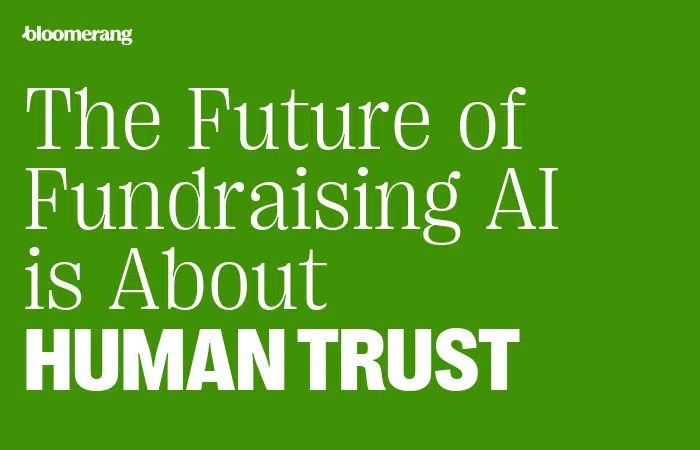Why the Future of Fundraising AI Is About Human Trust, Not Automation


When it comes to artificial intelligence, it’s easy to get swept up in the promise of automation—the idea that technology can take repetitive tasks off our plates, helping us save time and become more efficient.
But for nonprofits, the future of fundraising AI won’t be defined by automation or even time saved. It will be defined by trust.
Because fundraising, at its core, is human work. It’s built on empathy, relationships, and credibility. And in a sector where trust is deeply interconnected with giving and tech adoption, the question isn’t how much we can automate, it’s how deeply we can be trusted to use AI responsibly.
Because in a sector built on relationships, trust is the true currency of generosity.
Across the nonprofit sector, we’re seeing a familiar pattern: high curiosity about AI, but high hesitation.
In Bloomerang’s most recent AI survey, over 60% of nonprofit professionals said they view AI in their CRM positively—primarily for efficiency and automation. Yet nearly a third expressed reservations about data privacy, accuracy, and the fear of losing human connection. I believe this skepticism is rooted in something deeper than the technology’s ability to perform—it was about whether the technology could be trusted to serve the mission faithfully.
This mirrors national sentiment. Gallup’s Reward, Risk, and Regulation report found that while nearly all Americans have been exposed to AI, only 8% describe themselves as “very knowledgeable,” and a full 60% say they don’t trust AI to make fair or unbiased decisions.
In other words, nonprofits aren’t afraid of what AI can do; they’re afraid of what it might do to them—to their data, their donors, and their integrity.
Building trust in AI requires building it with integrity. For nonprofit software providers, this starts with responsible data stewardship and explainable systems–not technology that hides its reasoning, but tools that are open and accountable, reflecting the same transparency nonprofits promise to their donors
At Bloomerang, ethics aren’t an afterthought; they’re embedded by design. Our AI fundraising partner, Penny, lives within the secure walls of the Bloomerang Giving Platform, not as a third-party add-on. That means:
Because ethical AI isn’t a checkbox. It’s a reflection of nonprofit values—transparency, stewardship, and trust. If our customers can’t look at our technology and see their own integrity in it, we’ve missed the mark.
When we started building Penny, we approached it differently than most. We didn’t start with technology and ask, “How can we fit this into fundraising?”
We started with fundraising itself—with the hundreds of hours of strategy sessions and playbooks created by Bloomerang’s own nonprofit consultants. Those real-world insights became Penny’s foundation.
That means when Penny makes a recommendation, it’s not just pulling from a generic model; it’s reflecting the expertise of people who’ve been in the trenches. And when you ask why she made that recommendation, she can tell you—showing the logic and sources behind every suggestion.
That transparency matters. It’s how trust is earned—and how technology stays accountable to the humans it’s meant to serve.
We’re entering a new chapter in the AI journey—one where the early hype is giving way to real, grounded work. If the early hype around AI was defined by novelty, 2025 is about accountability.
Many organizations tried first-generation AI tools, only to be disappointed by inaccuracies, privacy risks, or “robotic” experiences. That’s the trough of disillusionment—when enthusiasm gives way to scrutiny.
But this is also where the real opportunity lies. Gallup found that people who use AI regularly are twice as likely to trust it as those who don’t. That means exposure, transparency, and clear communication about how AI works can rebuild confidence over time. The goal isn’t blind trust—it’s earned trust, reinforced by real-world performance and ethical transparency.
At Bloomerang, we’ve built Penny to do just that: to bridge expertise and execution, combining human insight with the efficiency of technology. Not as a replacement for people—but as a partner in purpose.
AI’s greatest promise isn’t automation—it’s augmentation. It’s not about replacing fundraisers; it’s about amplifying their brilliance.
Automation focuses on efficiency — completing repetitive tasks faster and at scale. It’s useful for processing data, generating reports, or sending reminders. But if left unchecked, it can also make fundraising feel mechanical—more about transactions than relationships.
Augmentation, by contrast, keeps the human at the center. It’s about using AI to enhance human judgment, not replace it. When fundraisers can spend less time managing data and more time engaging people, activity goes up—more campaigns, more outreach, more events. And higher activity leads to stronger relationships and, ultimately, more giving. That’s the real promise of AI in fundraising: not fewer human touches, but more meaningful ones.
According to Bloomerang’s 2025 AI User Research, the top nonprofit use cases for AI are data analysis (70%), writing donor emails (68%), and campaign brainstorming—all tasks that amplify creativity and strategy rather than remove the human touch.
When built responsibly, AI gives fundraisers more time to do what only humans can:
Automation might make things faster. Trust and transparency are what turn automation into augmentation. When AI shows its work and respects donor privacy, fundraisers can engage with it as a true partner— not a black box simply automating tasks.
In the next 18 months, we’ll see nonprofits move from fear to fluency—from asking, “Can I use AI?” to asking, “How can I use it to deepen generosity?”
And the answer will always come back to trust. Donors give to people they believe in. Teams adopt tools they feel safe using. And missions thrive when integrity guides innovation.
That’s why at Bloomerang, we’re not just building AI for fundraising. We’re building AI fundraisers can believe in—secure, explainable, and grounded in the same human values and experience that power generosity itself. Because the future of fundraising AI isn’t about replacing the human element; it’s about amplifying it.
Comments